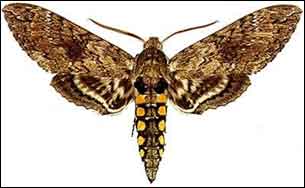New study in moths shows insects not entirely ruled by instinct

By examining the brain activity of moths, researchers have found that the behavior of these insects isn’t ruled entirely by instinct. Rather, they can learn which odors mean food.
The findings are more than academic: The researchers hope to develop methods for using trained moths to detect odors of interest for defense industry and law enforcement – such as odors given off by biological and chemical weapons.
Animal behaviorists have historically argued that most insects have a programmed response to a variety of situations, such as knowing which odors signal the presence of food and mates. But scientists are discovering that animals don’t always instinctively know what to do. In these cases, they have to learn, said Kevin Daly, the study’s lead author and a research scientist in entomology at Ohio State University.
He and his colleagues used tiny electrodes implanted in the heads of sphinx moths to continuously monitor the insect’s neuronal activity and feeding behavior before, during and after training the animal that one odor meant food – sugar water – was on the way and another odor did not.
“We saw a dramatic restructuring of the neural networks that convert scent into a code that the rest of the brain can understand,” Daly said. “The changes in this coding suggest that the moths learned to differentiate between an odor that meant food and an odor that didn’t.”
Understanding how moths detect and discriminate between scents could have wide-reaching applications. In related work, Daly and his colleagues are training moths and bees to detect odors from manufactured explosives.
“In principle, if we can understand how insects learn and distinguish between odors, we could ’train’ these animals to recognize any detectable odor of interest,” he said.
The findings currently appear online in the Proceedings of the National Academy of Sciences.
The electrodes placed in the moths’ brains registered the activity of neurons. Electrodes were also placed on feeding muscles to monitor the activity of the proboscis – a long tube that a moth uses for feeding – when the insects were exposed to different odors and to sugar. The researchers wanted to see how a moth’s nervous system changed its response to an odor that was associated with food and how the moth responded behaviorally to that odor.
The moths were restrained in plastic tubes, leaving the antennae and proboscis accessible. Electrodes were inserted into each insect’s head; Daly said that brain recordings could be made for up to 48 hours in these conditions. These moths normally live for a few days as adults.
The investigators put the bound moths through different odor conditioning trials: one created a clear relationship between an odor and food. In this case, the researchers wanted to see what happened in the brain and proboscis before, during and after the moths were exposed to the food-associated odor. In the second trial, moths were exposed to two odors, but only one predicted food. Both trials exposed moths to a series of 20 millisecond-long puffs of odor.
When odor predicted food, the researchers saw a significant and progressive increase – by about 60 percent – in the number of neurons responding to the odor. This increase in the neural network response indicated that the moths learned to associate the odor with food.
The researchers also saw striking differences in neuronal activity between the odor that predicted food and the odor that had nothing to do with food.
“More neurons were recruited into action when a moth smelled the odor connected to food,” Daly said. “After a few exposures to this odor, moths automatically started sucking for the food, even when they weren’t rewarded with food. They also learned to not respond to the odor that was unrelated to food. “After learning, the way their nervous system responded to odor changed,” he said.
Now that he and his colleagues have documented these nervous system changes, their next step is to take a deeper look into the neural networks and figure out what causes them to respond to changes.
“This study is a first pass at trying to understand how sensory neural networks code information, and how that coding process changes as an animal gains experience,” Daly said. “Ultimately, if we really want to understand how an animal changes its behavior, we have to go into the brain,” he continued.
Daly conducted the research with Brian Smith, a professor of entomology at Ohio State, and in collaboration with Thomas Christensen, Hong Lei and John Hildebrand, all with the University of Arizona in Tucson.
The National Institutes of Health and the Defense Advanced Research Projects Agency funded this study.
Media Contact
More Information:
http://www.osu.eduAll latest news from the category: Life Sciences and Chemistry
Articles and reports from the Life Sciences and chemistry area deal with applied and basic research into modern biology, chemistry and human medicine.
Valuable information can be found on a range of life sciences fields including bacteriology, biochemistry, bionics, bioinformatics, biophysics, biotechnology, genetics, geobotany, human biology, marine biology, microbiology, molecular biology, cellular biology, zoology, bioinorganic chemistry, microchemistry and environmental chemistry.
Newest articles

Parallel Paths: Understanding Malaria Resistance in Chimpanzees and Humans
The closest relatives of humans adapt genetically to habitats and infections Survival of the Fittest: Genetic Adaptations Uncovered in Chimpanzees Görlitz, 10.01.2025. Chimpanzees have genetic adaptations that help them survive…

You are What You Eat—Stanford Study Links Fiber to Anti-Cancer Gene Modulation
The Fiber Gap: A Growing Concern in American Diets Fiber is well known to be an important part of a healthy diet, yet less than 10% of Americans eat the minimum recommended…

Trust Your Gut—RNA-Protein Discovery for Better Immunity
HIRI researchers uncover control mechanisms of polysaccharide utilization in Bacteroides thetaiotaomicron. Researchers at the Helmholtz Institute for RNA-based Infection Research (HIRI) and the Julius-Maximilians-Universität (JMU) in Würzburg have identified a…



